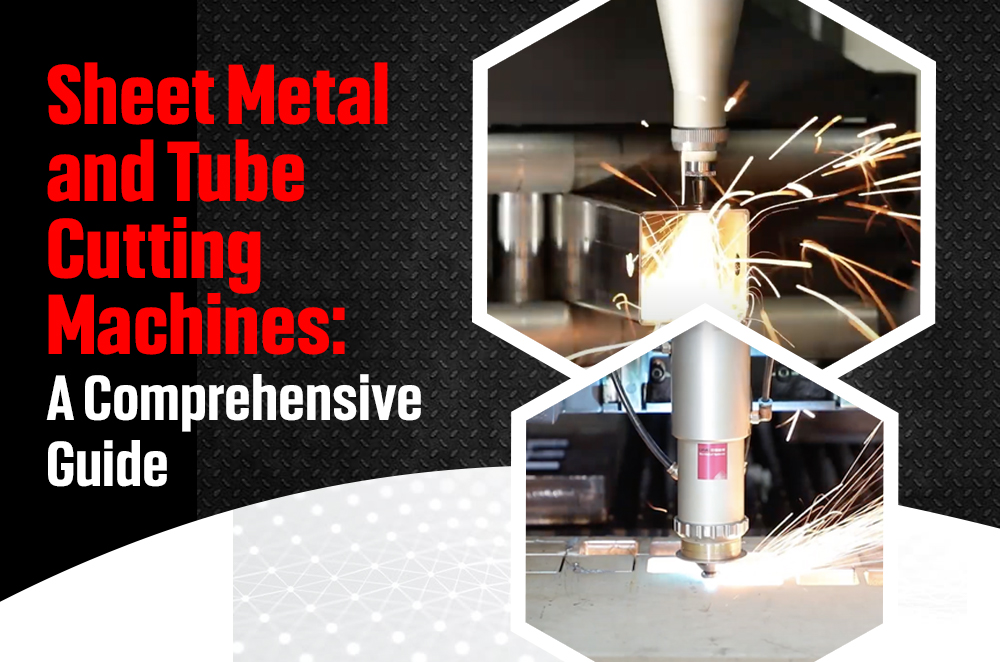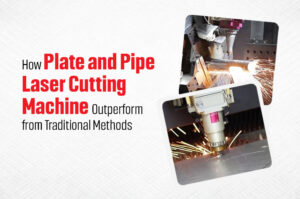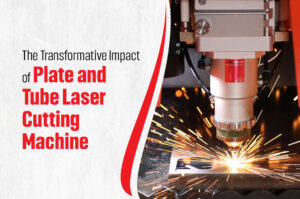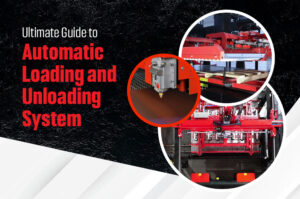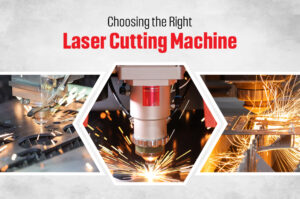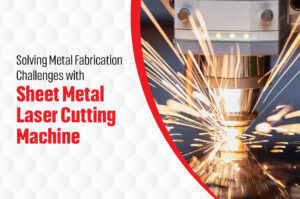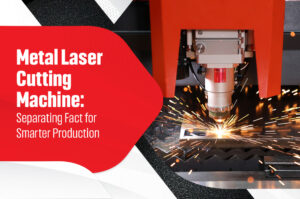Sheet metal and tube cutting machines have revolutionized the manufacturing landscape by offering precise, efficient, and versatile solutions for cutting metals in various industries. This comprehensive guide explores the key aspects of these machines, their cutting technologies, applications, and the factors to consider when choosing the right machine for your specific needs. Whether you are involved in automotive manufacturing, construction, aerospace, or any other industry requiring precise metal cutting, this blog provides an in-depth understanding of sheet metal and tube cutting machines.
What Are Sheet Metal and Tube Cutting Machines?
Sheet metal and tube cutting machines are specialized tools designed to cut flat metal sheets and cylindrical tubes into precise shapes and sizes. These machines utilize various cutting technologies, each suited to different types of materials and thicknesses. Sheet metal cutting machines are used to cut flat metal sheets into components such as panels, brackets, and enclosures, while tube cutting machines handle the cutting of metal tubes into specific lengths and shapes for structural components in machinery and other applications.
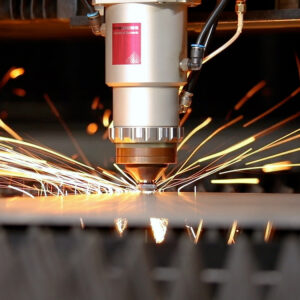 Key Features of Sheet Metal and Tube Cutting Machines:
Key Features of Sheet Metal and Tube Cutting Machines:
Precision: They ensure high accuracy and consistency in cuts, crucial for manufacturing components that require tight tolerances.
Versatility: Capable of handling a wide range of materials including steel, aluminum, brass, and titanium, depending on the cutting technology used.
Efficiency: Modern machines are equipped with advanced automation features, such as CNC controls, which enhance cutting speed and reduce production times.
Reduced Waste: These machines minimize material waste through precision cutting, making them a cost-effective solution for high-volume manufacturing.
Safety: Incorporate safety features like protective enclosures, automatic shut-off systems, and user-friendly interfaces to protect operators.
Types of Cutting Technologies
1. Fiber Laser Cutting Technology
Fiber laser cutting is one of the most popular technologies for sheet metal and tube cutting due to its high precision and speed. Fiber lasers use a laser beam generated by an optical fiber to cut through metal, producing clean, high-quality edges with minimal heat-affected zones. This technology is ideal for cutting thin to medium-thick sheets of various materials.
Advantages:
High Speed: Fiber lasers are known for their rapid cutting speeds, which significantly reduce production time.
Precision: Offers excellent cut quality with fine details and sharp edges, essential for intricate designs.
Low Operating Costs: Fiber lasers have lower maintenance requirements and consume less energy compared to other laser technologies.
Versatility: Suitable for a wide range of metals including mild steel, stainless steel, aluminum, and even some non-metals like plastics and wood.
2. Plasma Cutting Technology
Plasma cutting is ideal for thicker materials, up to several inches in thickness. It uses a high-velocity stream of ionized gas (plasma) to cut through conductive metals.
Advantages:
Cost-Effective: Lower initial investment compared to fiber lasers, making it accessible for smaller businesses.
Versatility: Can cut a variety of conductive metals including steel, aluminum, and copper.
Speed: Faster cutting speeds for thicker materials, making it efficient for industrial applications.
3. Waterjet Cutting Technology
Waterjet cutting uses a high-pressure stream of water mixed with abrasive particles to cut through almost any material without thermal distortion. This makes it particularly suitable for cutting heat-sensitive materials.
Advantages:
No Heat-Affected Zone: Maintains the integrity of heat-sensitive materials by avoiding thermal damage.
Flexibility: Can cut virtually any material including metal, glass, stone, and composites.
Smooth Cuts: Produces clean, burr-free edges without requiring post-cutting finishing.
Environmental Friendly: Uses only water and abrasives, making it an eco-friendly option.
4. CNC Cutting Technology
Computer Numerical Control (CNC) systems are integral to modern sheet metal and tube cutting machines. These systems automate the cutting process, enabling high precision and repeatability. CNC-controlled machines are ideal for intricate designs and high-volume production runs.
Advantages:
High Precision: Offers consistent cutting quality across multiple parts.
Automation: Reduces manual labor and the potential for human error.
Flexibility: Allows for quick changes in cutting patterns and designs, making them versatile for various manufacturing needs.
Increased Productivity: CNC machines can handle complex cutting tasks, improving overall productivity in the manufacturing process.
Components of Sheet Metal and Tube Cutting Machines
The design and components of plate and pipe laser cutting machine is crucial to their operation and performance. Understanding these components helps in selecting the right machine for your needs and ensures optimal performance over time.
1. Laser Source
The laser source is the heart of a fiber laser cutting machine, responsible for generating the laser beam. Fiber lasers are preferred for their efficiency, low maintenance, and ability to cut through a wide range of metals with high precision.
Key Features:
Wavelength: Determines the absorption rate by different metals. Fiber lasers operate at a wavelength of around 1.06 microns, which is well absorbed by most metals.
Power Options: Machines are available with varying power outputs, from 1 kW for thin materials to 20 kW for thick sheets.
Cooling System: Ensures consistent operation and prolongs the life of the laser source.
2. Cutting Head
The cutting head focuses the laser beam onto the material, delivering precise cutting. It includes lenses, nozzles, and a focusing system.
Key Considerations:
Lens Quality: High-quality lenses maintain beam quality and improve cut quality.
Nozzle Design: Proper nozzle design reduces laser reflections and improves cut quality.
Focusing Mechanism: Precision focusing ensures that the laser energy is concentrated correctly for optimal cutting.
3. Control System
The control system is the brain of the machine, directing all movements of the cutting head and the workpiece. Modern CNC controls provide a user-friendly interface, real-time monitoring, and advanced software for cutting path optimization.
Key Features:
User Interface: Intuitive touchscreens and software interfaces make the machine easy to operate.
Software: Advanced software for nesting, cut path optimization, and error detection.
Networking Capabilities: Allows for remote monitoring and troubleshooting, improving maintenance and productivity.
4. Worktable or Fixture
The worktable holds the material securely during the cutting process. It ensures stability and alignment of the material for precise cuts.
Key Features:
Material Support: Adequate support prevents material movement during cutting, ensuring accuracy.
Clamp Mechanism: Provides secure clamping to avoid shifting during the cutting process.
Material Handling Systems: Some machines offer automatic loading and unloading systems to enhance efficiency.
5. Cooling System
Cooling systems maintain optimal operating temperatures for the laser source and other critical components.
Key Features:
Water Circulation System: Ensures components remain cool during long cutting runs, preventing overheating and extending component life.
Heat Exchangers: Help in dissipating heat from laser sources and cutting heads, ensuring stable performance.
Air Cooling Systems: Some machines use air cooling for components to reduce operational costs.
Benefits of Sheet Metal and Tube Cutting Machines
Investing in advanced sheet metal and tube cutting machines offers several advantages that enhance manufacturing processes and outcomes:
1. Precision and Accuracy
The precision offered by these machines is unmatched, ensuring that every cut is exact, reducing material waste and eliminating the need for additional finishing processes. This is especially important in industries such as aerospace and automotive, where tight tolerances are critical.
2. Speed and Efficiency
Modern plate and tube laser cutting machine is designed for speed, enabling manufacturers to meet high production demands quickly and efficiently. Fiber lasers, for instance, can cut through metal at significantly higher speeds and reduce cycle times and improves overall productivity.
3. Versatility
These machines can handle a variety of metals and materials, making them adaptable to different manufacturing needs. They are capable of cutting various sheet sizes and tube diameters, accommodating different industrial applications from structural components to small, intricate parts.
4. Cost-Effectiveness
By minimizing material waste, reducing manual labor, and enhancing productivity, these machines offer a strong return on investment. They also feature lower operating costs due to the energy-efficient fiber laser sources and advanced automation systems.
5. Enhanced Safety
Modern machines come equipped with safety features that protect operators from potential hazards associated with cutting operations. Features like protective enclosures, emergency stop buttons, and automatic shut-off systems are common across models, ensuring a safe working environment.
6. Maintenance
Regular maintenance is essential to ensure the longevity and optimal performance of sheet metal and tube cutting machines. Machines are designed for easy maintenance, with features like easy-access panels, modular components, and diagnostic tools that simplify troubleshooting and reduce downtime.
Factors to Consider When Choosing a Sheet Metal or Tube Cutting Machine
Selecting the right cutting machine is crucial for optimizing your manufacturing processes.
Here are the key factors to consider:
1. Type of Material The type of metal you work with will influence the choice of cutting technology. For instance, fiber lasers are ideal for thin to medium-thick sheets, while plasma cutters are better for thicker metals. Waterjet cutting is suitable for heat-sensitive materials.
2. Material Thickness The thickness of the material you need to cut will determine the cutting technology and machine specifications. Fiber lasers and plasma cutters are effective for different thickness ranges, with fiber lasers handling thinner materials and plasma cutters suited for thicker materials.
3. Cutting Speed and Efficiency Consider the cutting speed required for your operations. High-speed machines like fiber lasers are suitable for high-volume production, while plasma cutters may offer a more cost-effective solution for thicker materials.
4. Precision and Quality Evaluate the required precision and cut quality. Fiber lasers offer superior edge quality and minimal heat-affected zones, making them ideal for intricate parts. Waterjet cutting provides smooth with burr free cuts.
5. Automation and Control Systems Modern sheet metal and tube cutting machines often come with CNC controls for automated cutting paths, reducing manual labor and enhancing productivity. Consider machines with advanced automation features like automatic loading/unloading systems, which improve efficiency.
6. Maintenance and Support Choose machines that are easy to maintain with readily available parts and strong after-sales support. This ensures minimal downtime and optimal machine performance over its lifespan.
7. Budget and Return on Investment Evaluate the cost of the machine versus the benefits it offers in terms of reduced material waste, increased productivity, and lower operating costs. High initial investment in fiber laser machines may be justified by long-term savings and improved production capabilities.
Choosing Business Point International for Sheet Metal and Tube Cutting Machines
Business Point International is a leading supplier of advanced sheet metal and tube cutting machines, offering a range of options to suit various industrial needs. Choosing us for your cutting machine needs provides numerous benefits.
Expertise and Experience: With years of experience in supplying industrial machinery, we offer expert guidance to help you select the right machine for your specific requirements.
Quality Products: Our machines are sourced from reputable manufacturers known for their cutting-edge technology, reliability, and durability.
Comprehensive Support: From installation to maintenance and training, we provide comprehensive support to ensure your machine operates optimally throughout its lifecycle.
Customization Options: We offer machines with customizable features to meet specific cutting requirements, ensuring a perfect fit for your production processes.
Cost-Effective Solutions: Our machines provide a high return on investment due to their efficiency, precision, and low operating costs, making them an ideal choice for businesses aiming to enhance their manufacturing capabilities.
Conclusion
Sheet metal and tube cutting machines have transformed the manufacturing landscape, offering precision, efficiency, and cost-effectiveness in cutting operations. Choosing the right machine involves considering factors such as the type of material, material thickness, cutting speed, precision, automation, and budget. Business Point International offers a range of high-quality machines that cater to these needs, providing tailored solutions to enhance your manufacturing processes. Whether you are in the automotive, aerospace, construction, or any other industry, investing in advanced sheet metal and tube cutting machines can significantly boost your production capabilities and reduce costs.

